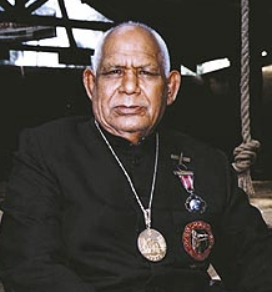
Khan Market is a shopping district and retail market in New Delhi, India. It was established in 1951 by the newly constituted Republic of India's Rehabilitation Ministry to give economic opportunities to refugees of the Partition of India, especially those from the North West Frontier Province (NWFP), now Khyber Pakhtunkhwa, a province in Pakistan. Many such refugees had arrived in the Delhi region. It is named after Khan Abdul Jabbar Khan, also known as Dr. Khan Sahib, who was the Chief Minister of NWFP from 1945 to 1947, and who had helped many refugees to escape without harm. Khan was the elder brother of the Pashtun- and Indian-freedom activist Khan Abdul Gaffar Khan. In 2019, Khan Market was rated as the world's 20th most expensive commercial street by Cushman & Wakefield.
The Chandni Chowk is one of the oldest and busiest markets in Old Delhi, India. It is located close to the Old Delhi Railway Station. The Red Fort monument is located at the eastern end of Chandni Chowk. It was built in the 17th century by the Mughal Emperor, Shah Jahan, and designed by his daughter, Jahanara. The market was once divided by canals to reflect moonlight. It remains one of India's largest wholesale markets.
South Extension or New Delhi South Extension (NDSE) is a neighbourhood of South Delhi, India. It is also described as a premier shopping destination. Situated on the Ring Road, Delhi, just east of All India Institute of Medical Sciences. The colony is divided into two parts - South Extension I and South Extension II. It has a population of about 50,000 people in South Extension Part 1 and 27,000 in South Extension Part 2.

Karol Bagh is a neighborhood in Central District of Delhi, India. It is a mixed residential and commercial neighborhood known for shopping streets, such as the Ghaffar Market and Ajmal Khan Road.

Radha Soami is a spiritual tradition or faith founded by Shiv Dayal Singh in 1861 on Basant Panchami Day in Agra, India.

Paharganj is a neighbourhood of Central Delhi, located just west of the New Delhi Railway Station. Known as Shahganj or King's ganj or market place during Mughal era, it is one of the three administrative subdivisions, of the Central Delhi district, of the National Capital Territory of Delhi, with the other two being, Darya Ganj and Karol Bagh.

Old Delhi is an area in the Central Delhi district of Delhi, India. It was founded as a walled city named Shahjahanabad in 1648, when Shah Jahan decided to shift the Mughal capital from Agra. The construction of the city was completed in 1648, and it remained the capital of Mughal India until its fall in 1857, when the British Empire took over as paramount power in the Indian subcontinent.
Ramakrishna Puram popularly known as R.K. Puram, is a residential colony in Delhi. Named after the saint Sri Ramakrishna, it houses many high-profile corporate houses.
Rajouri Garden is a market and residential neighbourhood in West Delhi, India. The Main Market and Nehru Market are the key markets of the area. The population is largely Punjabi who migrated to Delhi, following the Partition of India, from Pakistan in 1947. The postal code of Rajouri Garden is 110027.
Gulabi Bagh is one of the oldest and planned residential areas that lies north of central Delhi, India, adjacent to Ashok Vihar, Shakti Nagar, Kamla Nagar, Karol Bagh. Famous for its greenery and fresh air, it is often characterized by its famous (monkey) park that is adjacent to it.
The Civil Lines is a residential area and one of the 3 subdivisions of the Central Delhi district of Delhi in India. It is one of the 12 zones under the Municipal Corporation of Delhi. It was the hub of European-style hotels in the city until New Delhi came into being in 1911. The official residence of the Lieutenant Governor of Delhi is also located at Raj Niwas Marg, Civil Lines.
Roop Nagar is a residential district in Delhi, India. It is close to the Delhi metro station Vishwavidyalaya Metro Station and the GTB Nagar Metro Station. It is next to the Kamla Nagar market of North Delhi and the Delhi University, North Campus.

Rajendra Nagar is a residential colony in Central Delhi, Delhi, India. The name comes from Dr. Rajendra Prasad, the first president of India. It is bordered by the Central Ridge Protected Forest on the east and south, IARI on the west, and Karol Bagh on the north. It is a constituency in the Legislative Assembly of Delhi. The current Councillor for the Municipal Corporation of Delhi is Aarti Chawla of Aam Aadmi Party.
Delhi Sadar Lok Sabha constituency was one of the Lok Sabha (parliamentary) constituencies in the National Capital Territory of Delhi from 1956 to 2008.

Guru Hanuman actual name Vijay Pal Yadav was a legendary wrestling coach of India who coached many medal-winning wrestlers. He was awarded the prestigious Dronacharya Award in 1987, the highest recognition for a sports coach in India, and the Padma Shri in 1983.

Salig Ram, popularly known by the honorific "Huzur Maharaj" and by the government-conferred title "Rai Bahadur," was born in Peepal Mandi, Agra, on 14 March 1829. He served as chief inspector of post offices in British India, and, in 1881, was Postmaster-General of the North-Western Provinces, based in Allahabad. He was the first Indian to hold the position.
Guru Radha Kishan (1925-1996) was an Indian Independence activist and Communist politician.
For other places with the same name, see Wazirabad (disambiguation)

The Battle of Delhi was fought between Khalsa Sikhs and the Mughal Empire in 1783.










